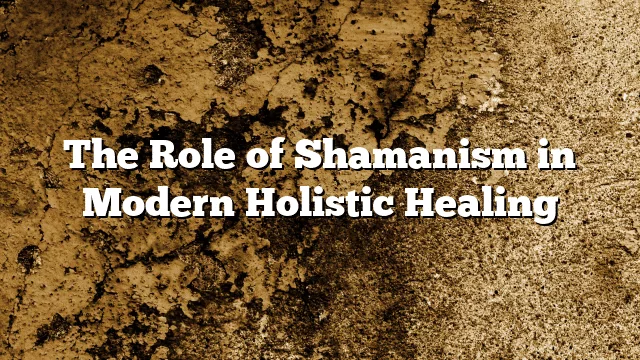
The Role of Shamanism in Modern Holistic Healing
Shamans are spiritual healers who use trance states to enter the invisible world and locate and heal any spirits responsible for physical illness. Additionally, shamans often use herbal medicine or natural treatments in order to restore health.
Shamanic healing work is an integral component of modern holistic medicine and may be combined with other forms of alternative care for added benefits. People seeking an enhanced spiritual experience can especially gain from consulting a qualified shaman.
Shamanic Practitioners
Shamanic healing is an ancient, holistic practice that draws from spiritual and metaphysical energies to promote client health and healing. Practitioners of this art often work alongside other holistic health care professionals such as physicians, chiropractors, acupuncturists, yoga teachers and massage therapists to deliver care.
Shamans are traditional healers from native societies who utilize trance or altered states of consciousness to enter the invisible world and communicate with spirits, animals, nature spirits and other non-physical entities to facilitate healing and guide their communities.
Many who have experienced shamanic healing have found its work life-altering, particularly those struggling with mental or emotional issues, addictions, pain management or illness and disease. Many report receiving relief from symptoms while also increasing quality of life and receiving guidance about their future lives.
Modern shamans often specialize in holistic health care and seek training to expand their spiritual knowledge. This may involve studying with indigenous medicine people, attending larger established schools or traveling overseas to study shamanism among native cultures.
Some shamans choose to live in rural areas in order to remain more connected to their culture and tradition, thus maintaining their practice more successfully and limiting distractions from daily life in cities.
Others in urban areas can practice in an ashram or spiritual community where conditions are conducive to practicing shamanic healing, particularly beneficial when facing difficult relationships, financial challenges or chronic illnesses.
By entering into trance-like states, shamans access the invisible world to communicate with spirits or non-physical beings impacted by their clients’ issues and to make changes that will have an effect on physical realities. They may use this time to effect change within these other realms that will impact physical reality directly.
Shamanism’s place in holistic healing has grown increasingly important over time, often being turned to when other methods fail or when traditional medical care or psychiatric therapy has not proven sufficient for client. Shamanism offers safe and effective alternatives that may benefit clients in need.
Shamanic Techniques
Shamanism is an ancient spiritual practice that is becoming increasingly popular in modern holistic healing. This form of alternative states of consciousness involves entering the spirit world to gain guidance and assistance from spirits; an ideal way for helping individuals cope with life or find healing.
Shamanic techniques have become an increasingly popular field among psychologists, registered nurses, and medical doctors, who study its principles to apply them in both their personal lives and professional practices. Many professionals train directly with one or more shamans either individually or in small groups.
These practitioners are skilled in using shamanic rituals and trance state experiences as part of their clinical work with patients experiencing emotional, psychological or spiritual issues. Furthermore, they may communicate with guardian spirits or spiritual guides during treatments for more effective results.
At shamanic ceremonies, shamans employ various objects that induce trance states or induce an ecstatic state. These objects often made of natural materials can be carved, fashioned, and painted as needed to achieve this state.
Some objects are designed to produce a trance or ecstatic state by stimulating synchronized alpha and theta brainwave discharges, and have proven successful at increasing self-awareness, learning and memory.
Additionally, these shamanic activities can foster an atmosphere of connection and belonging with members of your community as well as create a feeling of safety and security for participants in ceremonies.
Social integration has proven to be one of the key elements of shamanic healing, from providing a sense of belonging to developing interpersonal skills and rejoining society.
Winkelman attributes these benefits to shamanic practices and believes they have a profoundly integrative effect on human cognition. She notes how such rituals and ecstatic states create intense connections between limbic structures in lower brain structures and frontal brain regions through intensified connections, projecting slow wave (theta) discharges into these frontal brain regions which in turn trigger increased attention, self awareness, learning and memory abilities, while simultaneously mediating mechanisms which mediate self-attachments, motivations and feelings of conviction.
Shamanic Practices
Modern holistic healing uses shamanism as an integral component in treating illness and health issues, serving as an effective complementary therapy alongside allopathic medicine and other traditional mental health therapies. Shamanism addresses spiritual aspects of physical ailments while aiding natural healing processes within the mind to repair physical bodies.
Shamanic practices involve traveling into the spiritual world or other realms of reality to access and work with helping spirits during shamanic journeys. These journeys enable shamans to tap into various resources such as spirit guides and power animals for accessing various types of spiritual assistance.
Shamans travel into trance states during these journeys and travel beyond their bodies into various spiritual realms – upper world, lower world and middle world are just some examples – where there may be humans-like beings, mythical beings and plants present.
A shaman is guided throughout their journey by spirits he or she comes in contact with, such as animals or gods. Additionally, various trance states occur along their journey and can provide unique experiences.
Trances can be very vibrant experiences that involve various kinds of visions that range from realistic to transcendent, helping shamans gain deeper insights into their client’s situation and to discover what causes them pain.
Trances also allow them to uncover the root cause of illness or disease, so they can remove its causes while curing patients by banishing any harmful spirits causing illness.
Shamanism is an integral and revered part of many cultures and a key contributor to many forms of indigenous healing, including rituals, ceremonies and rites of passage.
One of the most widely practiced shamanic practices includes trance state journeys, negative energy extraction and spiritual cleansing – practices which may provide great help for individuals suffering from various emotional, mental or physical illnesses.
Professional psychologists and medical doctors who seek to incorporate shamanic practices into their lives as well as care of others are increasingly turning towards studying shamanism. Many enroll in training programs for this practice, studying with indigenous shamans around the globe. Students learn principles such as curing and healing as well as other topics which support spiritual and emotional well-being for themselves and their clients.
Shamanic Healing
Shamanism’s Role in Modern Holistic Healing
Shamanism is an ancient spiritual practice used to restore balance and harmony to people’s lives through holistic healing practices. Since antiquity, shamanism has been employed as an essential component of holistic medicine practices worldwide.
People seek help from shamans when their physical, mental or emotional symptoms cannot be effectively managed with traditional medicine. Unlike other holistic healing modalities which focus on managing symptoms rather than finding and healing their source, shamanic healing aims to identify and eliminate root causes for illness.
Shamans enter a trance state through rhythmic drumming or chanting to travel into non-ordinary reality and gain information on what may be the source of suffering; then return with healing instructions for their client.
Shamans use rituals such as power animal retrieval to connect their clients with powerful spirits who help them overcome obstacles and reach their fullest potential. This practice is known as power animal retrieval.
The shaman will then work closely with their client to rebuild relationships between spirits and individuals and restore power in their life, often taking multiple sessions for this process to be complete.
When searching for a shaman, make sure you find someone trained and experienced in this type of healing. Furthermore, find someone with whom you feel at ease – someone willing to discuss your past and current circumstances safely in an open and nurturing atmosphere.
At a shamanic healing session, your shaman will assess your energy centers to identify any obstructions impeding the flow of vital energy. They may use Reiki or sound healing to clear away these blockages and restore your natural flow of vitality.
Negative energies that hinder your body’s natural ability to heal itself could include disharmony in your life, fear or feeling powerless over decisions made for you by others. A professional can then work to clear away these obstructions to healing.
